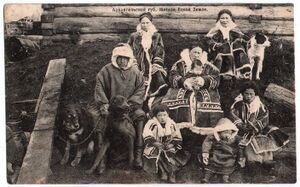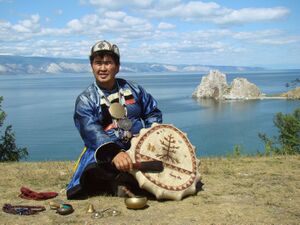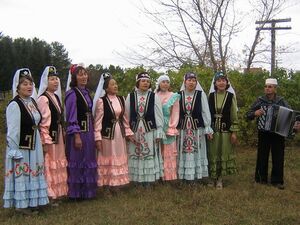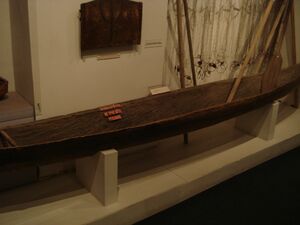الشعوب الأصلية في سيبيريا
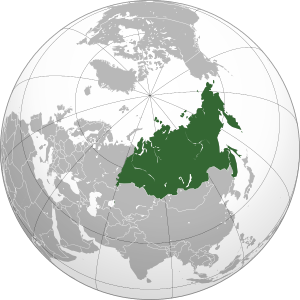 | |
| إجمالي التعداد | |
|---|---|
| 1.6–1.8 million[1] 5% of the total population | |
| المناطق ذات التجمعات المعتبرة | |
| Siberia | |
| اللغات | |
| Ainu, Chukotko-Kamchatkan, Mongolic, Nivkh, Tungusic, Turkic, Uralic, Yeniseian (Ket), and Yukaghir languages | |
| الدين | |
| Siberian Shamanism, Tengrism, Tibetan Buddhism, Russian Orthodox Christianity |
Siberia is a vast region spanning the northern part of the Asian continent, and forming the Asiatic portion of Russia. As a result of the Russian conquest of Siberia (17th to 19th centuries) and of the subsequent population movements during the Soviet era (1917-1991), the modern-day demographics of Siberia is dominated by ethnic Russians (Siberiaks) and other Slavs. However, there remains a slowly increasing number of indigenous groups, accounting for about 5% of the total Siberian population (about 1.6–1.8 million),[1] some of which are closely genetically related to indigenous peoples of the Americas.[2]
History

In Kamchatka, the Itelmens' uprisings against Russian rule in 1706, 1731, and 1741, were crushed. During the first uprising the Itelmen were armed with only stone weapons, but in later uprisings they used gunpowder weapons. The Russian Cossacks faced tougher resistance from the Koryaks, who revolted with bows and guns from 1745 to 1756, and were even forced to give up in their attempts to wipe out the Chukchi in 1729, 1730–31, and 1744–47.[3] After the Russian defeat in 1729 at Chukchi hands, the Russian commander Major Dmitry Pavlutsky was responsible for the Russian war against the Chukchi and the mass slaughters and enslavement of Chukchi women and children in 1730–31, but his cruelty only made the Chukchis fight more fiercely.[4]
A war against the Chukchis and Koryaks was ordered by Empress Elizabeth in 1742 to totally expel them from their native lands and erase their culture through war. The command was that the natives be "totally extirpated" with Pavlutskiy leading again in this war from 1744 to 1747 in which he led to the Cossacks "with the help of Almighty God and to the good fortune of Her Imperial Highness", to slaughter the Chukchi men and enslave their women and children as booty. However this phase of the war came to an inconclusive end, when the Chukchi forced them to give up by killing Pavlutskiy and decapitating him.[5]
The Russians launched wars and conducted mass slaughters against the Koryaks in 1744 and 1753–54. After the Russians tried to force the natives to convert to Christianity, different native peoples such as the Koryaks, Chukchis, Itelmens, and Yukaghirs all united to drive the Russians out of their land in the 1740s, culminating in the assault on Nizhnekamchatsk fort in 1746.[6] After its annexation by Russia in 1697, around 100,000 of 150,000 Itelmen and Koryaks died due to infectious diseases such as smallpox, mass suicides and the mass slaughters perpetrated by the Cossacks throughout the first decades of Russian rule.[7]
The genocide by the Russian Cossacks devastated the native peoples of Kamchatka and exterminated much of their population.[8][9] In addition to committing genocide, the Cossacks also devastated the wildlife by slaughtering massive numbers of animals for fur.[10] Ninety percent of the Kamchadals and half of the Vogules were killed from the 18th to 19th centuries. The rapid genocide of the indigenous population led to entire ethnic groups being entirely wiped out, with around 12 exterminated groups which were named by Nikolai Iadrintsev as of 1882. Much of the slaughter was brought on by the Siberian fur trade.[11]
In the 17th century, indigenous peoples of the Amur region were attacked and colonized by Russians who came to be known as "red-beards".[12] The Russian Cossacks were named luocha (羅剎) or rakshasa by Amur natives, after demons found in Buddhist mythology. The natives of the Amur region feared the invaders as they ruthlessly colonized the Amur tribes, who were tributaries of the Qing dynasty during the Sino–Russian border conflicts. Qing forces and Korean musketeers who were allied with the Qing defeated the Cossacks in 1658, which kept the Russians out of the inner reaches of the Amur region for decades.[13]
The regionalist oblastniki were, in the 19th century, among the Russians in Siberia who acknowledged that the natives were subjected to violence of almost genocidal proportions by the Russian colonization. They claimed that they would rectify the situation with their proposed regionalist policies.[14] The colonizers used massacres, alcoholism and disease to bring the natives under their control. Some small nomadic groups essentially disappeared, and much of the evidence of their obliteration has itself been destroyed, with only a few artifacts documenting their presence remaining in Russian museums and collections.[15]
The Russian colonization of Siberia and conquest of its indigenous peoples has been compared to European colonization in the United States and its natives, with similar negative impacts on the natives and the appropriation of their land.
From 1918 to 1921, there was a violent revolutionary upheaval in Siberia during the Russian Civil War. Russian Cossacks under Captain Grigori Semionov established themselves as warlords by crushing the indigenous peoples who resisted them.[16] The Czechoslovak Legion initially took control of Vladivostok and controlled all of the territory along the Trans-Siberian Railway by September 1918.[17][18] The Legion later declared its neutrality and was evacuated via Vladivostok.
Today, Kamchatka is largely populated by a Russian majority, although decreasing, with a slowly increasing indigenous population. The Slavic Russians outnumber all of the native peoples in Siberia and its cities except in Tuva and Sakha (where the Tuvans and Yakuts serve as the majority ethnic groups respectively), with the Slavic Russians making up the majority in Buryatia and the Altai Republic, outnumbering the Buryat and Altai natives.
The Buryats make about 33% of their own Republic, the Altai make up about 37%, and the Chukchi 28%; Evenks, Khanty, Mansi, and Nenets are outnumbered by non-natives by nearly 90% of the population. The Czars and Soviets enacted policies to force natives to change their way of life, while rewarding ethnic Russians with the natives' reindeer herds and wild game they had confiscated. The reindeer herds have been mismanaged to the point of extinction.[بحاجة لمصدر]
Overview
Siberia is a sparsely populated region. Historically it has been home to a variety of different linguistic groups. According to some estimates, by the beginning of the 17th century, indigenous peoples numbered 160,000. In the 1897 census, their number was 822,000.[19] The 2021 census recorded 1,620,000 indigenous Siberians.[1]


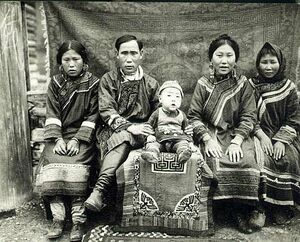

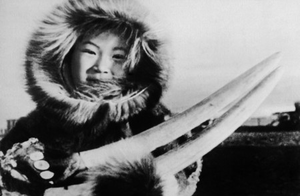
| Indigenous peoples of Siberia | ||
|---|---|---|
| Ethnic group | Population (2021) | Population (2010) |
| Siberian Turkic | ▲ 945,930 | 924,136 |
| Yakuts | 478,409 | 478,085 |
| Tuvans | 295,384 | 263,934 |
| Altai | 78,125 | 74,238 |
| Khakas | 61,365 | 72,959 |
| Shors | 10,507 | 12,888 |
| Dolgans | 8,157 | 7,885 |
| Siberian Tatars* | 6,297 | 6,779 |
| Soyot | 4,368 | 3,608 |
| Teleuts | 2,217 | 2,643 |
| Tofalar | 719 | 762 |
| Chulyms | 382 | 355 |
| Mongolic | 461,389 | |
| Buryats | 460,053 | 461,389 |
| Uralic | ▲ 97,687 | 92,590 |
| Samoyedic | 53,992 | 49,378 |
| Nenets | 49,646 | 44,640 |
| Selkup | 3,458 | 3,649 |
| Nganasan | 687 | 862 |
| Enets | 201 | 227 |
| Ugric | 43,695 | 43,212 |
| Khanty | 31,467 | 30,943 |
| Mansi | 12,228 | 12,269 |
| Tungusic | 77,894 | |
| Evenks | 39,226 | 38,396 |
| Evens | 19,913 | 21,830 |
| Nanai | 11,623 | 12,003 |
| Ulchs | 2,472 | 2,765 |
| Udege | 1,325 | 1,496 |
| Orochs | 527 | 596 |
| Negidals | 481 | 513 |
| Oroks | 268 | 295 |
| Paleosiberian | 37,461 | |
| Chukotko-Kamchatkan | 27,851 | 28,985 |
| Chukchi | 16,200 | 15,908 |
| Koryaks | 7,485 | 7,953 |
| Itelmens | 2,596 | 3,193 |
| Kamchadals | 1,547 | 1,927 |
| Kereks | 23 | 4 |
| Nivkh (Nivkh) | 3,842 | 4,652 |
| Yukaghir | 2,702 | 2,605 |
| Yukaghir | 1,802 | 1,603 |
| Chuvans | 900 | 1,002 |
| Yeniseian (Kets) | 1,088 | 1,219 |
| Eskaleut | 2,220 | |
| Siberian Yupik | 1,657 | 1,738 |
| Aleuts | 397 | 482 |
| Sino-Tibetan | 274 | |
| Taz | 235 | 274 |
| Total | ▲ 1,619,685 | 1,595,964 |
- Some estimates put the population of Siberian Tatars at 200,000.[20][21]
Ainu people
Ainu languages are spoken on Sakhalin, Hokkaido, the Kurils, and on the Kamchatka Peninsula, as well as in the Amur region. Today, Ainu is nearly extinct, with the last native speakers remaining in Hokkaido and on Kamchatka.
Mongolic peoples
The Buryats number 461,389 in Russia according to the 2010 census, which makes them the second largest ethnic minority group in Siberia. They are mainly concentrated in their homeland, the Buryat Republic, a federal subject of Russia. They are the northernmost major group of the Mongols.[22]
Buryats share many customs with their Mongolian cousins, including nomadic herding and erecting huts for shelter. Today, the majority of Buryats live in and around Ulan Ude, the capital of the republic, although many live more traditionally in the countryside. Their language is called Buryat.
In Zabaykalsky Krai of Russia, in Mongolia and China, there are also the Hamnigans—a Mongolic ethno-linguistic (sub)group as Mongolized Evenks.
Paleosiberian peoples
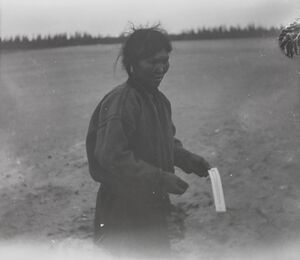
Four small language families and isolates, not known to have any linguistic relationship to each other, compose the Paleo-Siberian languages:
Chukotko-Kamchatkan
- 1. The Chukotko-Kamchatkan family, sometimes known as Luoravetlan, includes Chukchi and its close relatives, Koryak, Alutor, and Kerek. Itelmen, also known as Kamchadal, is also distantly related. Chukchi, Koryak and Alutor are spoken in easternmost Siberia by communities numbering in the dozens (Alutor) to thousands (Chukchi). Kerek is now extinct, and Itelmen is now spoken by fewer than 10 people, mostly elderly, on the west coast of the Kamchatka Peninsula.
Nivkh
- 2. Nivkh is spoken in the lower Amur basin and on the northern half of Sakhalin island. It has a recent modern literature and the Nivkhs have experienced a turbulent history in the last century.
Yeniseian
- 3. Ket is the last survivor of the Yeniseian family along the middle of the Yenisei River and its tributaries. It has recently been claimed [1] to be related to the Na-Dene languages of North America, though this hypothesis has met with mixed reviews among historical linguists. In the past, attempts have been made to relate it to Sino-Tibetan, North Caucasian, and Burushaski.[بحاجة لمصدر]
Yukaghir
- 4. Yukaghir is spoken in two mutually unintelligible varieties in the lower Kolyma and Indigirka valleys. Other languages, including Chuvantsy, spoken further inland and further east, are now extinct. Yukaghir is held by some to be related to the Uralic languages.[بحاجة لمصدر]
Tungusic peoples
The Evenks live in the Evenk Autonomous Okrug of Russia.
The Udege, Ulchs, Evens, and Nanai (also known as Hezhen) are also indigenous peoples of Siberia, and are known to share genetic affinity to indigenous peoples of the Americas.[23]
Turkic peoples
The Siberian Turks include the following ethnic groups:
- Altaians
- Chulyms
- Dolgans
- Khakas
- Kumandins
- Shors
- Siberian Tatars
- Soyots
- Teleuts
- Tofalar
- Tuvans
- Yakuts
Uralic peoples
Ugrians
The Khanty (obsolete: Ostyaks) and Mansi (obsolete: Voguls) live in Khanty–Mansi Autonomous Okrug, a region historically known as "Yugra" in Russia. By 2013, oil and gas companies had already devastated much of the Khanty tribes' lands. In 2014 the Khanty-Mansi regional parliament continued to weaken legislation that had previously protected Khanty and Mansi communities. Tribes' permission was required before oil and gas companies could enter their land.[24]
Samoyeds
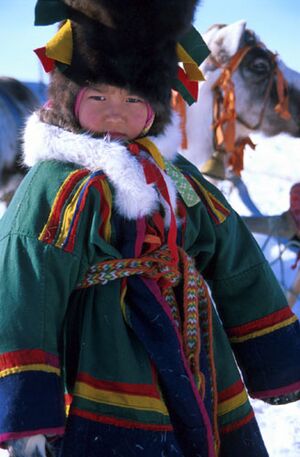
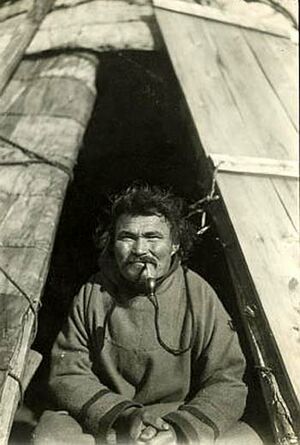
Samoyedic peoples include:
- Northern Samoyedic peoples
- Southern Samoyedic peoples
Yukaghir group
Yukaghir is spoken in two mutually unintelligible varieties in the lower Kolyma and Indigirka valleys. Other languages, including Chuvantsy, spoken further inland and further east, are now extinct. Yukaghir is held by some to be related to the Uralic languages in the Uralic–Yukaghir family.
The Yukaghirs (self-designation: одул odul, деткиль detkil) are people in East Siberia, living in the basin of the Kolyma River. The Tundra Yukaghirs live in the Lower Kolyma region in the Sakha Republic; the Taiga Yukaghirs in the Upper Kolyma region in the Sakha Republic and in Srednekansky District of Magadan Oblast. By the time of Russian colonization in the 17th century, the Yukaghir tribal groups (Chuvans, Khodyns, Anauls, etc.) occupied territories from the Lena River to the mouth of the Anadyr River.
The number of the Yukaghirs decreased between the 17th and 19th centuries due to epidemics, internecine wars and Tsarist colonial policy. Some of the Yukaghirs have assimilated with the Yakuts, Evens, and Russians. Currently Yukaghirs live in the Sakha Republic and the Chukotka Autonomous Okrug of the Russian Federation. In the 2002 Census, their total number was 1,509 people, up from 1,112 in the 1989 Census.
Genetic relationships and links to indigenous peoples of the Americas


The earliest indigenous peoples of Siberia were hunter-gatherers distantly related to modern Europeans, and diverged from a shared ancestral population around 38kya before populating Siberia. In Siberia, they received geneflow from an East-Eurasian population, most closely related to the 40kya old Tianyuan man (c. 22-50%), representing a deep sister lineage of contemporary East Asian people, giving rise to a distinct Siberian lineage known as Ancient North Eurasian. By c. 32kya, populations carrying ANE-related ancestry were probably widely distributed across northeast Eurasia.[26][27][note 1]
Around 36kya an Ancient East Asian population diverged from other East Asians somewhere in Southern China and migrated northwards into Siberia, were they encountered and interacted with the Ancient North Eurasians to give rise to the Paleo-Siberians and the Ancestral Native Americans. The Ancestral Native Americans would became isolated in the Beringia region, and subsequently populate the Americas.[28]
The last historical population movement can be associated with the Neo-Siberian expansion outgoing from Northeast Asia (15kya), and contributed ancestry to indigenous groups throughout Siberia as well as to Native Americans, associated with the expansion of Paleo-Eskimo, and Eskimo-Aleut groups. Modern indigenous peoples of Siberia derive varying degrees of ancestry from these three layers, although the Ancient North Eurasian like ancestry has been largely replaced.[29][30]
Indigenous Siberians may also derive low amounts of ancestry from another deep Eurasian lineage samplified by the Ust'-Ishim man, previously suggested to have not contributed to any modern human population.[31] Overall, Indigenous Siberians and other Northern Asians form a distinct cluster within the wider Eurasian genetic diversity, with their relative closest affinity towards Indigenous peoples of the Americas and Eastern Asians.[32]
Early Native Americans are thought to have crossed into the Americas across the Beringia land bridge between 40,000 and 13,000 years ago from modern day Siberia. Certain modern indigenous Siberians are closely related to the Indigenous peoples of the Americas, with whom they share a common origin.[33][34]
Analysis of genetic markers has also been used to link the two groups of indigenous peoples. Studies focused on looking at markers on the Y chromosome, which is always inherited by sons from their fathers. Haplogroup Q is a unique mutation shared among most indigenous peoples of the Americas, less among Siberian populations. Studies have found that 93.8% of Siberia's Ket people and 66.4% of Siberia's Selkup people possess the mutation, while it is largely absent from other populations in Eastern Asia or Europe.[35]
The principal-component analysis suggests a close genetic relatedness between some North American Amerindians (the Chipewyan [Dënesųłı̨ne] and the Cheyenne) and certain populations of central/southern Siberia (particularly the Kets, Yakuts, Selkups, and Altaians), at the resolution of major Y-chromosome haplogroups.[36] This pattern agrees with the distribution of mtDNA haplogroup X, which is found in North America, is absent from eastern Siberia, but is present in the Altaians of southern central Siberia.[36]
Culture and customs

This section requires expansion. (December 2009) |
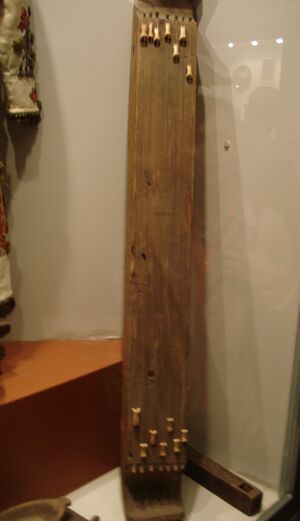
Customs and beliefs vary greatly among different tribes.
The Chukchi wore laminar armour of hardened leather reinforced by wood and bones.[38]
Kutkh (also Kutkha, Kootkha, Kutq Kutcha and other variants, Russian: Кутх), is a raven spirit traditionally revered by the Chukchi and other Siberian tribal groups. He is said to be very powerful.[39]
Toko'yoto or the "Crab" was the Chukchi god of the sea.[40]
Nu'tenut is the chief god of the Chukchi.[41]
The Chukchi also respect reindeer in both mortal and holy life. They have several rituals involving them.[42]
The Supreme Deity of the Yukaghirs is called Pon, which means "Something".[43] He is described as very powerful.[44]
Literature
- Rubcova, E.S.: Materials on the Language and Folklore of the Eskimoes, Vol. I, Chaplino Dialect. Academy of Sciences of the USSR, Moskva * Leningrad, 1954
- Menovščikov, G. A. (= Г. А. Меновщиков) (1968). "Popular Conceptions, Religious Beliefs and Rites of the Asiatic Eskimoes". In Diószegi, Vilmos (ed.). Popular beliefs and folklore tradition in Siberia. Budapest: Akadémiai Kiadó.
- Barüske, Heinz: Eskimo Märchen. Eugen Diederichs Verlag, Düsseldorf and Köln, 1969.
- Merkur, Daniel: Becoming Half Hidden / Shamanism and Initiation Among the Inuit. Acta Universitatis Stockholmiensis / Stockholm Studies in Comparative Religion. Almqvist & Wiksell, Stockholm, 1985.
- Kleivan, I. and Sonne, B.: Eskimos / Greenland and Canada. (Series: Iconography of religions, section VIII /Arctic Peoples/, fascicle 2). Institute of Religious Iconography • State University Groningen. E.J. Brill, Leiden (The Netherland), 1985. ISBN 90-04-07160-1.
See also
- Ancient Beringian, Siberian indigenous people.
- History of Siberia
- Demographics of Siberia
- First All Union Census of the Soviet Union
- Indigenous people
- List of ethnic groups
- Y-DNA haplogroups in populations of Central and North Asia
- Pomors
- Kola Norwegians
- Uralic languages
- Shamanism in Siberia
- List of indigenous peoples of Russia
- List of small-numbered indigenous peoples of Russia
- Small-numbered indigenous peoples of Extreme North
- Circumpolar peoples
- Indigenous peoples of the Subarctic
Footnotes
- ^ Sikora et al. (2019) model the Yana individuals as 22% East Eurasian and the remainder West Eurasian. Massilani et al. (2020) model the Yana individuals as around one-third East Eurasian and two-thirds West Eurasian.Vallini et al. (2022) model Yana as 50% West Eurasian and 50% East Eurasian.
Citations
- ^ أ ب ت "Национальный состав населения". Federal State Statistics Service. Retrieved 30 December 2022.
- ^
Zimmer, Carl (June 5, 2019). "Who Were the Ancestors of Native Americans? A Lost People in Siberia, Scientists Say". The New York Times. Retrieved April 5, 2020.
Dr. Willerslev's team found DNA in the Kolyma skull as well. A small fraction of that individual's ancestry came from Ancient North Siberians. But most of it came from a new population. Dr. Willerslev and his colleagues call them the Ancient Paleo-Siberians.
The DNA of the Ancient Paleo-Siberians is remarkably similar to that of Native Americans. Dr. Willerslev estimates that Native Americans can trace about two-thirds of their ancestry to these previously unknown people.
One reason that the Ancient Paleo-Siberians were unknown until now is that they were mostly replaced by a third population of people with a different East Asian ancestry. This group moved into Siberia only in the past 10,000 years — and they are the progenitors of most living Siberians. - ^ Black, Jeremy (1 October 2008). War and the World: Military Power and the Fate of Continents, 1450-2000. Yale University Press. ISBN 978-0300147698. Retrieved 4 May 2018 – via Google Books.
- ^ Forsyth 1994, pp. 145-6.
- ^ Forsyth 1994, p. 146.
- ^ Forsyth 1994, p. 147.
- ^ Jack 2008, p. 388.
- ^ "Condé Nast's Traveler, Volume 36" 2001, p. 280.
- ^ "Yearbook" 1992, p. 46.
- ^ Mote 1998, p. 44.
- ^ Etkind 2013, p. 78.
- ^ Stephan 1996, p. 64.
- ^ Emory Endeavors: Transnational Encounters in Asia (PDF). CreateSpace Independent Publishing Platform. 2012. ISBN 978-1475138795. Retrieved 2020-04-08 – via Emory College of Arts and Sciences | Department of History.
- ^ Wood 2011, p. 89–90.
- ^ Bobrick, Benson (15 December 2002). "How the East Was Won". The New York Times. Archived from the original on 24 September 2017. Retrieved 4 May 2018.
- ^ Bisher 2006.
- ^ "Czech troops take Russian port of Vladivostok for Allies". History.com. Archived from the original on 26 December 2017.
- ^ Brent Mueggenberg, Czecho-Slovak Struggle, p. 161–177, 188–191.
- ^ Долгих, Борис Осипович (1960). Родовой и племенной состав народов Сибири в XVII веке (in الروسية). Moscow: Издательство Академии наук СССР. p. 615.
- ^ Сибирские татары // Российский этнографический музей.
- ^ "Siberian Tatars". Archived from the original on 2002-02-27.
- ^ The New Encyclopædia Britannica, 15th Edition. (1977). Vol. II, p. 396. ISBN 0-85229-315-1.
- ^ Torroni, A; Sukernik, R I; Schurr, T G; Starikorskaya, Y B; Cabell, M F; Crawford, M H; Comuzzie, A G; Wallace, D C (September 1993). "mtDNA variation of aboriginal Siberians reveals distinct genetic affinities with Native Americans". American Journal of Human Genetics. 53 (3): 591–608. ISSN 0002-9297. PMC 1682407. PMID 7688933.
- ^ "Reindeer herders take on Russian oil-giant as tribal rights in Siberia weakened". Survival International. 13 May 2014. Retrieved 1 September 2014.
- ^ Yu, He; Spyrou, Maria A.; Karapetian, Marina; Shnaider, Svetlana; Radzevičiūtė, Rita; Nägele, Kathrin; Neumann, Gunnar U.; Penske, Sandra; Zech, Jana; Lucas, Mary; LeRoux, Petrus; Roberts, Patrick; Pavlenok, Galina; Buzhilova, Alexandra; Posth, Cosimo (2020-06-11). "Paleolithic to Bronze Age Siberians Reveal Connections with First Americans and across Eurasia". Cell (in الإنجليزية). 181 (6): 1232–1245.e20. doi:10.1016/j.cell.2020.04.037. ISSN 0092-8674. PMID 32437661. S2CID 218710761.
- ^ Cassidy, Jim; Ponkratova, Irina; Fitzhugh, Ben, eds. (2022). Maritime Prehistory of Northeast Asia. The Archaeology of Asia-Pacific Navigation (in الإنجليزية). Vol. 6. doi:10.1007/978-981-19-1118-7. ISBN 978-981-19-1117-0. S2CID 249355636.
- ^ Sikora, Martin; Pitulko, Vladimir V.; Sousa, Vitor C.; Allentoft, Morten E.; Vinner, Lasse; Rasmussen, Simon; Margaryan, Ashot; de Barros Damgaard, Peter; de la Fuente, Constanza; Renaud, Gabriel; Yang, Melinda A.; Fu, Qiaomei; Dupanloup, Isabelle; Giampoudakis, Konstantinos; Nogués-Bravo, David (June 2019). "The population history of northeastern Siberia since the Pleistocene". Nature (in الإنجليزية). 570 (7760): 182–188. Bibcode:2019Natur.570..182S. doi:10.1038/s41586-019-1279-z. ISSN 1476-4687. PMID 31168093. S2CID 174809069.
- ^ Sapiens (2022-02-08). "A Genetic Chronicle of the First Peoples in the Americas". SAPIENS (in الإنجليزية الأمريكية). Retrieved 2023-04-03.
- ^ Sikora, Martin; Pitulko, Vladimir V.; Sousa, Vitor C.; Allentoft, Morten E.; Vinner, Lasse; Rasmussen, Simon; Margaryan, Ashot; de Barros Damgaard, Peter; de la Fuente, Constanza; Renaud, Gabriel; Yang, Melinda A.; Fu, Qiaomei; Dupanloup, Isabelle; Giampoudakis, Konstantinos; Nogués-Bravo, David (June 2019). "The population history of northeastern Siberia since the Pleistocene". Nature (in الإنجليزية). 570 (7760): 182–188. Bibcode:2019Natur.570..182S. doi:10.1038/s41586-019-1279-z. ISSN 1476-4687. PMID 31168093. S2CID 174809069.
- ^ Svobodová, Ing Andrea. "Long-standing dispute about North American prehistory / University of Ostrava". University of Ostrava (in التشيكية). Retrieved 2023-02-07.
- ^ Wong, Emily H. M.; Khrunin, Andrey; Nichols, Larissa; Pushkarev, Dmitry; Khokhrin, Denis; Verbenko, Dmitry; Evgrafov, Oleg; Knowles, James; Novembre, John; Limborska, Svetlana; Valouev, Anton (January 2017). "Reconstructing genetic history of Siberian and Northeastern European populations". Genome Research. 27 (1): 1–14. doi:10.1101/gr.202945.115. ISSN 1549-5469. PMC 5204334. PMID 27965293.
- ^ Kidd, Kenneth K.; Evsanaa, Baigalmaa; Togtokh, Ariunaa; Brissenden, Jane E.; Roscoe, Janet M.; Dogan, Mustafa; Neophytou, Pavlos I.; Gurkan, Cemal; Bulbul, Ozlem; Cherni, Lotfi; Speed, William C.; Murtha, Michael; Kidd, Judith R.; Pakstis, Andrew J. (2022-05-04). "North Asian population relationships in a global context". Scientific Reports (in الإنجليزية). 12 (1): 7214. Bibcode:2022NatSR..12.7214K. doi:10.1038/s41598-022-10706-x. ISSN 2045-2322. PMC 9068624. PMID 35508562.
- ^ Yang, Melinda A. (2022-01-06). "A genetic history of migration, diversification, and admixture in Asia". Human Population Genetics and Genomics (in الإنجليزية). 2 (1): 1–32. doi:10.47248/hpgg2202010001. ISSN 2770-5005.
- ^ Zhang, Xiaoming; Ji, Xueping; Li, Chunmei; Yang, Tingyu; Huang, Jiahui; Zhao, Yinhui; Wu, Yun; Ma, Shiwu; Pang, Yuhong; Huang, Yanyi; He, Yaoxi; Su, Bing (2022-07-25). "A Late Pleistocene human genome from Southwest China". Current Biology (in English). 32 (14): 3095–3109.e5. doi:10.1016/j.cub.2022.06.016. ISSN 0960-9822. PMID 35839766. S2CID 250502011.
{{cite journal}}: CS1 maint: unrecognized language (link) - ^ "Learning Center :: Genebase Tutorials". Genebase.com. 1964-10-22. Archived from the original on 2013-11-17. Retrieved 2013-09-27.
- ^ أ ب Bortolini, MC; Salzano, FM; Thomas, MG; et al. (2003). "Y-chromosome evidence for differing ancient demographic histories in the Americas". Am. J. Hum. Genet. 73 (3): 524–39. doi:10.1086/377588. PMC 1180678. PMID 12900798.
- ^ "Tlingit, Eskimo and Aleut armors". Kunstamera. Archived from the original on 2014-02-22. Retrieved 2014-02-10.
- ^ "Tlingit, Eskimo, and Aleut armors". Kunst Kamera. 22 February 2014. Archived from the original on 2014-02-22.
- ^ Krasheninnikov, Stepan P. (1972). "The Kamchadal beliefs about God, the creation of the World and the tenets of their religion". Explorations of Kamchatka 1735-1741. Translated by Crownheart-Vaughn, E.A.P. Portland, OR: Oregon Historical Society. pp. 238–243. Archived from the original on 27 February 2021. Retrieved 16 May 2019 – via www.nordic-life.org.
- ^ Acta Universitatis Stockholmiensis: Stockholm studies in comparative religion. Almqvist & Wiksell. 1961. p. 68.
- ^ Bogoras, Waldemar (1909). The Chukchee. E.J. Brill Limited. p. 306.
- ^ Malandra, W.W. (1967). "The concept of movement in [the] history of religions: A religio-historical study of reindeer in the spiritual life of north Eurasian peoples". Numen. BRILL. 14 (Fasc. 1): 23–69.
- ^ Lurker, Manfred (2004). The Routledge dictionary of gods and goddesses, devils and demons (2nd ed.). London, UK: Taylor & Francis e-Library. p. 153. ISBN 0203643518.
- ^ Norenzayan, Ara (2013). Big Gods: How religion transformed cooperation and conflict. Princeton University Press. p. 129. ISBN 9781400848324.
References
- Batalden, Stephen K. (1997). The Newly Independent States of Eurasia: Handbook of Former Soviet Republics. Contributor Sandra L. Batalden (revised ed.). Greenwood Publishing Group. ISBN 978-0897749404. Retrieved 24 April 2014.
- Bisher, Jamie (16 January 2006). White Terror: Cossack Warlords of the Trans-Siberian. Routledge. p. 492. ISBN 978-1135765958. Retrieved 24 April 2014.
- Bobrick, Benson (December 15, 2002). "How the East Was Won". THE NEW YORK TIMES. Retrieved 24 May 2014.
- Black, Jeremy (2008). War and the World: Military Power and the Fate of Continents, 1450-2000. Yale University Press. ISBN 978-0300147698. Retrieved 24 April 2014.
- Etkind, Alexander (2013). Internal Colonization: Russia's Imperial Experience. John Wiley & Sons. ISBN 978-0745673547. Retrieved 24 April 2014.
- Forsyth, James (1994). A History of the Peoples of Siberia: Russia's North Asian Colony 1581-1990 (illustrated, reprint, revised ed.). Cambridge University Press. ISBN 978-0521477710. Retrieved 24 April 2014.
- Jack, Zachary Michael, ed. (2008). Inside the Ropes: Sportswriters Get Their Game On. U of Nebraska Press. ISBN 978-0803219076. Retrieved 24 April 2014.
- Kang, Hyeok Hweon (2013). "Big Heads and Buddhist Demons: The Korean Musketry Revolution and Northern Expeditions of 1654 and 1658". Journal of Chinese Military History. 2 (2): 127–189. doi:10.1163/22127453-12341256.
- Levene, Mark (2005). Genocide in the Age of the Nation State: Volume 2: The Rise of the West and the Coming of Genocide. I.B.Tauris. ISBN 978-0857712899. Retrieved 24 April 2014.
- Mote, Victor L. (1998). Siberia: worlds Apart. Westview series on the post-Soviet republics (illustrated ed.). Westview Press. ISBN 978-0813312989. Retrieved 24 April 2014.
- Pesterev, V. (2015). Siberian frontier: the territory of fear. Royal Geographical Society (with IBG), London.
- Stephan, John J. (1996). The Russian Far East: A History (illustrated, reprint ed.). Stanford University Press. ISBN 978-0804727013. Retrieved 24 April 2014.
- Wood, Alan (15 April 2011). Russia's Frozen Frontier: A History of Siberia and the Russian Far East 1581 - 1991 (illustrated ed.). A&C Black. ISBN 978-0340971246. Retrieved 24 April 2014, pp. 89–90.
{{cite book}}: External link in|postscript= - Condé Nast's Traveler, Volume 36. Condé Nast Publications. 2001. Retrieved 24 April 2014.
- Yearbook. Contributor International Work Group for Indigenous Affairs. International Work Group for Indigenous Affairs. 1992. Retrieved 24 April 2014.
{{cite book}}: CS1 maint: others (link)
External links
- Russian Association of Indigenous Peoples of the North
- "Endangered Languages of Indigenous Peoples of Siberia". UNESCO.
- "Atlas of the World's Languages in Danger". UNESCO.
- Endangered Uralic Peoples
- Minority languages of Russia on the Net Archived 20 أبريل 2009 at the Wayback Machine
- The Red Book of the peoples of the Russian Empire
- Survival International page on the Siberian Tribes
- L'auravetl'an Indigenous Information Network by Indigenous Peoples of Russia
- (in روسية) В погоне за малыми, an article about treatment of minorities in the Russian Empire, Kommersant-Money, October 25, 2005
- Mapping Indigenous Siberia: Spatial Changes and Ethnic Realities, 1900–2010. Ivan Sablin & Maria Savelyeva
- CS1 الروسية-language sources (ru)
- CS1 الإنجليزية الأمريكية-language sources (en-us)
- CS1 التشيكية-language sources (cs)
- Short description is different from Wikidata
- Articles using infobox ethnic group with image parameters
- Articles with hatnote templates targeting a nonexistent page
- Articles with unsourced statements from December 2021
- Articles with unsourced statements from December 2022
- Articles to be expanded from December 2009
- All articles to be expanded
- Portal-inline template with redlinked portals
- Pages with empty portal template
- CS1 maint: postscript
- CS1 maint: others
- Articles with روسية-language sources (ru)
- Ethnic groups in Siberia
- Indigenous peoples of North Asia
- North Asia
- Northeast Asia
- Russian Far East
